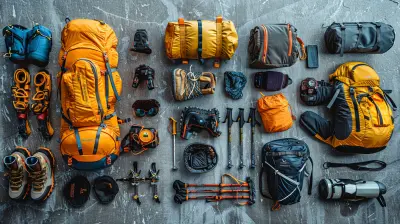How to Prevent Back Pain and Stiffness on Long Haul Flights
9 November 2025
Long-haul flights can be exciting because they usually mean you're off on a grand adventure. However, if you've ever been stuck in a cramped airplane seat for hours on end, you know the struggle—aching joints, a stiff back, and the feeling like you've just aged 10 years by the time you land.
The good news? You don’t have to suffer through it. With a few smart strategies, you can minimize discomfort, keep your body feeling fresh, and even walk off the plane feeling (almost) like you just boarded. Here’s how to prevent back pain and stiffness on long-haul flights. 
Why Do We Experience Back Pain on Long Flights?
Before we get into solutions, it helps to understand what’s causing the discomfort. The main culprits?- Prolonged Sitting: Our bodies aren't designed to sit still for hours, especially in an upright, slightly reclined position. Sitting for too long compresses the spine and reduces blood flow.
- Poor Posture: Slumping forward, slouching, or letting your head fall to one side while sleeping can strain your muscles and lead to stiffness.
- Limited Movement: Lack of movement means reduced circulation, leading to tight muscles, numbness, and even swelling in the legs.
- Seat Design: Let’s be real—airplane seats aren’t exactly ergonomic. They rarely support the natural curve of your spine, making back pain almost inevitable.
Now that we know the enemy, let’s fight back with some practical tips! 
1. Choose Your Seat Wisely
Not all airplane seats are created equal. The right seat can make a huge difference in preventing back pain.Best Seat Choices for Comfort
- Aisle Seat: More room to stretch your legs and move around.- Exit Row: Extra legroom for better blood circulation.
- Bulkhead Seat: No one is reclining into your space, allowing you to sit more comfortably.
- Business or Premium Economy: If you can splurge, the extra recline and legroom can ease discomfort significantly.
Seats to Avoid
- Middle Seat: You're boxed in with little space to move.- Back Row: Seats may not recline, and it's close to the bathrooms.
- Near the Wing: Less vibration but usually more crowded, limiting movement.
If you're booking economy, aim for an aisle or exit row seat whenever possible. 
2. Support Your Lower Back
Most airplane seats lack proper lumbar support, which can lead to lower back pain.Fix it:
- Bring a lumbar pillow or simply roll up a sweater and place it in the curve of your lower back.
- Use an inflatable travel cushion that adapts to your posture.
- If the seat is too hard, a thin seat cushion can prevent tailbone pain.
The goal is to maintain the natural curve of your spine rather than letting it collapse into the seat. 
3. Stretch and Move Regularly
Sitting still for hours is a guaranteed recipe for stiffness. Movement keeps your blood flowing and reduces muscle tension.In-Seat Stretches
Even if you're stuck in your seat, you can do these simple movements:- Ankle Rolls: Move your feet in circles to improve circulation.
- Seated Twists: Keep your back straight and twist gently from side to side.
- Neck Rolls: Lower your ear towards your shoulder and roll forward and back to release tension.
- Shoulder Shrugs: Lift your shoulders toward your ears, hold for a few seconds, then drop them down.
Standing Stretches
Whenever you get up, take a moment to stretch:- Standing Hamstring Stretch: Slightly bend forward to stretch the back of your legs.
- Quad Stretch: Pull one foot behind you toward your butt to open up your hips.
- Backbend Stretch: Place your hands on your lower back and gently arch backward to counteract hours of sitting.
Set a reminder (or use turbulence as a cue) to stand up and move every hour.
4. Adjust Your Posture
Posture is everything when it comes to preventing back pain.Proper Sitting Posture:
- Keep your back straight and against the seat.- Use a lumbar support pillow for lower back comfort.
- Keep both feet flat on the floor (or on a small footrest if needed).
- Avoid crossing your legs, as it restricts blood flow.
- Keep your knees at a 90-degree angle to reduce strain on your lower back.
Small adjustments can prevent hours of discomfort.
5. Stay Hydrated and Eat Smart
Why Hydration Matters
Dehydration can worsen stiffness and back pain. Airplane cabins have low humidity, which can dry out your muscles and joints.How to stay hydrated:
- Drink at least 8 ounces of water every hour.- Avoid excess alcohol and caffeine, which dehydrate you further.
- Bring a refillable water bottle and ask the flight attendants to fill it up.
Eat Anti-Inflammatory Snacks
What you eat also affects how your body feels. Stick to foods that reduce inflammation and muscle stiffness:- Nuts and seeds (almonds, walnuts)
- Fruits (bananas, oranges, berries)
- Vegetables (carrots, cucumbers, cherry tomatoes)
- Protein-rich snacks (hard-boiled eggs, cheese, lean turkey)
Avoid salty snacks that can cause bloating and discomfort.
6. Use Heat or Cold Therapy
If you often experience back pain, consider bringing a small heat pack to relax your muscles. Many reusable heat packs are TSA-approved and can be activated without electricity.Alternatively, a cold gel pack can reduce inflammation if you're dealing with swelling.
7. Sleep Smartly
If you're on an overnight flight, quality sleep can prevent stiffness.Tips for Better Sleep on a Plane:
- Use a Neck Pillow: It supports your head and prevents awkward strains.- Lean Slightly Back: Avoid sleeping while fully upright, which puts pressure on your spine.
- Support Your Lower Back: Again, use a small pillow or rolled-up jacket.
- Stretch Before Sleeping: Loosening up your muscles beforehand can prevent stiffness later.
- Avoid Sleeping on the Tray Table: It strains your neck and back.
8. Wear Comfortable Clothing
Tight clothing can restrict movement and contribute to discomfort.Best Travel Outfit Choices:
- Loose-Fitting Pants: Yoga or sweatpants allow for unrestricted movement.- Layered Tops: Helps regulate body temperature on a cold plane.
- Compression Socks: Prevent swelling and improve circulation, reducing stiffness.
- Supportive Shoes: Opt for comfortable sneakers over restrictive footwear.
9. Bring Pain Relief Essentials
Even with all these precautions, you might still feel some discomfort. Pack these essentials in your carry-on:- Pain relief patches (like menthol-based patches)
- Over-the-counter pain relievers (ibuprofen, acetaminophen)
- Essential oils (peppermint or lavender for muscle relaxation)
- Massage ball or mini foam roller (for deep tissue relief)
A little preparation can go a long way in avoiding unnecessary pain.
Final Thoughts
Long-haul flights don’t have to leave you feeling sore and stiff. With the right seat, proper posture, smart movement, and a few travel-friendly tricks, you can step off the plane feeling refreshed instead of wrecked.So next time you’re gearing up for a long flight, keep these tips in mind. Your back will thank you!
all images in this post were generated using AI tools
Category:
Long Haul FlightsAuthor:

Winona Newman

